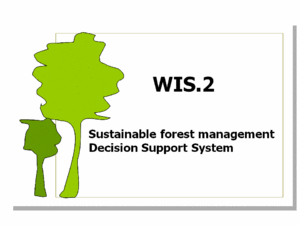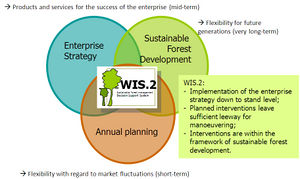Difference between revisions of "WIS.2"
| Line 108: | Line 108: | ||
* Categorisation of forest societies; | * Categorisation of forest societies; | ||
* Projection of demographic structure; | * Projection of demographic structure; | ||
| − | * GIS Layers (i.e., raster and vector files); | + | * GIS Layers (i.e., raster and vector files). |
| + | |||
| + | |||
| + | ='''Models'''= | ||
| + | |||
| + | =='''Forest Models'''== | ||
| + | Forest models that are taken into account with WIS.2 are: | ||
| + | * Forest growth models that are implemented to determine production goals and concepts, rejuvenation politics for steering the demographic development, and urgency of action in the stands with regard to the current state and future milestones; | ||
| + | * Intervention concepts for e.g. tending and thinning (i.e., when to intervene during the stand life, dominant dhb, how to reach the production targets efficiently); | ||
| + | * Demographic models for e.g. comparison of current age structure and demographic equilibrium, harvested area per decade and over maturing degree of the harvested stands; development of the overall tree species composition (i.e., visualization of how slowly changes occur); | ||
| + | * Growth functions for e.g. planned intervention for the next 10 years (i.e., overview of what, where and when); | ||
| + | * Expert recommendations on the scope of action for e.g. proportion of softwood or other phytosociological units. | ||
Revision as of 11:39, 18 November 2009
General System Description
Brief Overview
WIS.2 is a decision support system for monitoring and ensuring the sustainable, goal-oriented and efficient management of forest ecosystems, especially with regard to the:
- integral handling of significant spatial- and temporal scales in forest ecosystems (i.e., multiscalarity, sustainability);
- valorisation of intrinsic multiple ways of using the forest (i.e., multifunctionality, adaptability);
- implementation of a liberal and pragmatic view of silviculture as applied in Switzerland (i.e., flexibility, close-to-nature).
WIS.2, based on MS Access and ArcGIS ArcView, is composed of different applications, each handling a main aspect of the management of forest ecosystems. As a prototype, WIS.2 is currently being tested in three forest enterprises and promoted by a forest engineering firm. The tool is used at all levels of education for forest management in Switzerland.
WIS.2 was developed during 2001-2005 within the framework of a PhD thesis at the ETH in Zurich (Rosset, 2005 [1]), and has since then been successively developed in an iterative manner using inputs gained from practical experience. Plans are currently being made to refine the tool in a research and development project and launch a commercial product called SMART-Forest.
Scope of the System
WIS.2 focuses on providing guidance in sustainable forestry management. The system gives strong organisational and decision support in implementing and monitoring silvicultural practices. The system provides specific information for the different phases of the silvicultural process, allowing planners to simulate the mid- to long-term consequences of various action scenarios, and supporting users in solving complex silvicultural problems at multiple scales (i.e., from the whole enterprise level down to the single stand level; from short-term to very long-term). The scope of WIS.2 covers:
- defining different variations of silvicultural strategy and implementation concepts, in order to assess the engineering strategy and recognize the mid to long-term consequences;
- formalising the manifold demands of society, forest owners and stakeholders for implementation in forest management;
- pointing out the priority-of-action by connecting long-term strategic planning with mid-term harvesting planning;
- systematically documenting and reporting the decisions taken with regard to the managerial plan;
- facilitating regular control of the development of forest areas with regard to the realisation of the enterprise strategy;
- giving guidance on how to react in a flexible way to changes such as market fluctuations and unforeseen events like storms;
- enabling the user to handle the given complexity - step by step.
System Origin
As multi-purpose, near-to-nature silviculture seeks to steer forest dynamics towards socio-economic and conservation goals through minimal anthropogenic intervention, the necessity for a powerful forest management decision support system that implements and monitors such silvicultural practices is getting stronger. In order to face this challenge, WIS.1 was initially designed in the 1990s by Good and Pistor (1992[2]) as an information system for silvicultural planning at stand level. Under the name of WIS.2 the system subsequently evolved from an information system to a DSS by integrating knowledge and supporting the entire decision process of the management of forest ecosystems. Over the past few years, further adaptations have been subsequently made, such as e.g. during a 10-day course on silvicultural planning held at the ETHZ in a small forest enterprise (150ha) owned by the Canton of Zurich.
WIS.2 has real-life application scenarios on the level of forest management, education, as well as in research and development.
Forest management
In forest management the tool has been extensively applied in the:
- State forest of Teufen in Canton Zurich (i.e., the 10 day course);
- teaching and research forest of the ETH in Zurich;
- forest of the city of Winterthur[1];
- forest of the city of Rheinfelden[2];
- forest of the village of Bullet in Canton Vaud (diploma thesis);
Plans are currently being made to apply the tool in a forest in Canton Freiburg, as well as in a forest in Thailand (diploma thesis).
Education
WIS.2 is being applied at all levels of the education in forest management in Switzerland in order to illustrate and demonstrate forest planning.
The main motivation behind introducing WIS.2 in teaching is to:
- enhance awareness of the consequences of very slow tree growth by visualising long-term trends resulting from decisions taken (i.e., the necessity to ensure certain continuity);
- concentrate on concept building to derive urgency of intervention to be undertaken at stand level (i.e., how to steer forest dynamics in order to reach the production target as efficiently as possible) and subsequently visit each individual stand separately;
- elaborate on and compare different variations in forestry management.
Students who have used the prototype have been providing valuable feedback that is in an iterative manner to improve the IT-solution. Research and development: a further tool based on the same platform (WVK) is currently being developed[3].
Research and Development
WIS.2 is not yet a commercial product, however, a proposal is currently being written in order to be able to refine the system within the framework of a research project and launch a commercial product through collaborative partnerships under the name of SMART-Forest.
Support for specific issues
WIS.2 takes a multi-level, top-down, situation-oriented approach and provides foresters with room for maneuvering when specifically determining the most appropriate silvicultural techniques to use. The recommended forest strategy is subsequently implemented within the framework of sustainable forest development.
Silviculture in Switzerland
The liberal and pragmatic view of silviculture in Switzerland implies that the suggested strategy should leave as much room as possible for maneuvering when implementing the planned intervention.
Formalisation of the manifold demands of society and forest owners in silvicultural profiles
In order to meet the demands of society and forest owners, the objectives with regard to the desired status of the stands (what to reach), the given conditions of the location (where to intervene) and the related spatial organization (how to coordinate the procedure) need to be clearly specified. In WIS.2, this specification is described in the form of silvicultural profiles that define the desired status of the stands under the given local conditions. Silvicultural profiles are comprised of criteria (e.g., types of trees) and indicators that further specify the criteria (e.g., oak, fir, maple). The grading of the criteria is given at three levels: very important/ very appropriate, important/ appropriate, less important/ less appropriate.
Capabilities to support the decision-making process
WIS.2 supports silvicultural decision-making phases by:
- providing valuable information for the different phases of the process, and thus allowing planners to simulate mid- to long-term consequences in varying action scenarios;
- defining different variations of silvicultural strategy and implementation concepts;
- assessing the feasibility of action scenarios and revealing the long- and mid-term consequences;
- pointing out the priority of action by connecting long-term strategic planning with mid-term harvesting planning;
- giving guidance on how to react in a flexible way to changes such as market fluctuations and unforeseen events.
Data and Data Models
Typical spatial extent of application
The typical scale of use for the application is the forest enterprise that is comprised of forest stands. The average size of stands range from one to several hectares, and the size of enterprises range between a few hundred to several thousand hectares.
Forest data input
The following forest data are required as input to the system:
- Stand information (i.e., regular or irregular stand structure, development stage, tree species composition, cover density, hdom, Ddom, m3 per ha, level of coverage, location, stand goal, quality, sensitivity, origin, natural rejuvenation, biodiversity, measures to take, urgency);
- Phytosociological composition of the stands;
- Description of the relief such as exposition and slope;
- Information on the road network (i.e., accessibility);
- Tree species equilibrium;
- Necessity for rejuvenation of the stand;
- Categorisation of forest societies;
- Projection of demographic structure;
- GIS Layers (i.e., raster and vector files).
Models
Forest Models
Forest models that are taken into account with WIS.2 are:
- Forest growth models that are implemented to determine production goals and concepts, rejuvenation politics for steering the demographic development, and urgency of action in the stands with regard to the current state and future milestones;
- Intervention concepts for e.g. tending and thinning (i.e., when to intervene during the stand life, dominant dhb, how to reach the production targets efficiently);
- Demographic models for e.g. comparison of current age structure and demographic equilibrium, harvested area per decade and over maturing degree of the harvested stands; development of the overall tree species composition (i.e., visualization of how slowly changes occur);
- Growth functions for e.g. planned intervention for the next 10 years (i.e., overview of what, where and when);
- Expert recommendations on the scope of action for e.g. proportion of softwood or other phytosociological units.
References
Cited references
- ↑ Rosset, C. (2005): Systeme de gestion sylvicole integree et d’aide a la decision. Les WIS.2, un instrument informatique pour un sylvicole efficient et ceblee, durable, multifontionelle et proche de la nature. Diss. Nr. 16005, EPF Zurich, Zurich
- ↑ Good, E., Pistor, T., (1992): Waldbauliches Informationssystem WIS, Handbuch. Professur für Waldbau, ETH Zürich, Zürich

